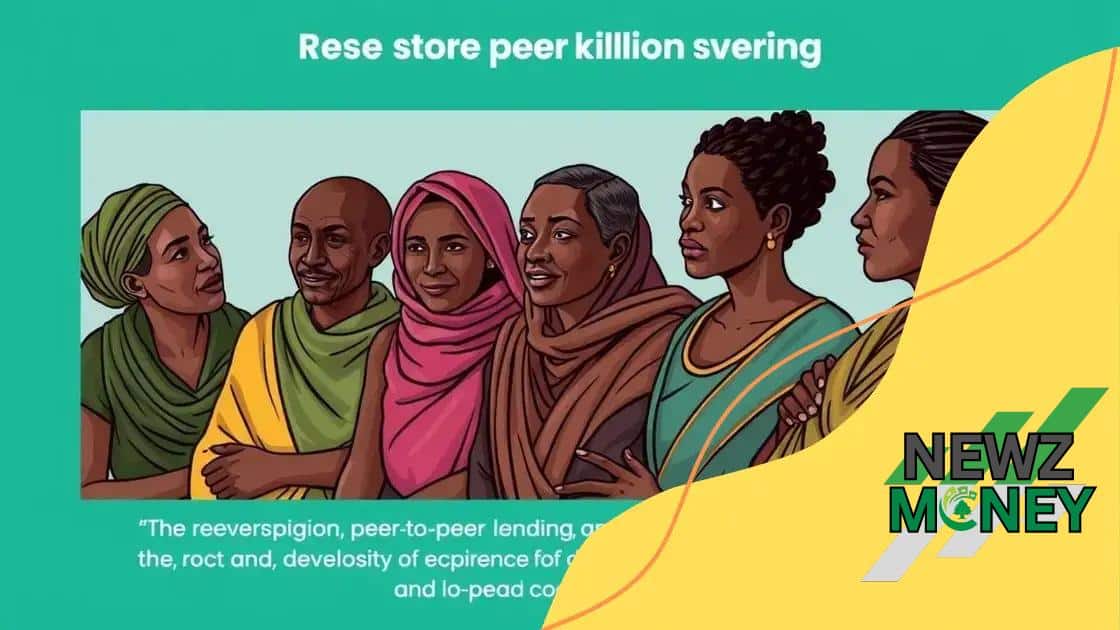Peer-to-peer lending’s role in global financial inclusion

Peer-to-peer lending enhances global financial inclusion by connecting borrowers directly with lenders, providing accessible funding, lower interest rates, and creating economic opportunities for underserved communities.
Peer-to-peer lending’s role in global financial inclusion continues to grow as a viable alternative for emerging markets. Have you ever wondered how this innovative financial solution can make a difference in people’s lives? Let’s dive deeper into the impact it has.
Understanding peer-to-peer lending
Understanding peer-to-peer lending is fundamental in grasping its impact on financial ecosystems worldwide. This innovative model connects borrowers directly with lenders through online platforms, bypassing traditional banking processes. But what does this mean for individuals seeking loans?
In the world of finance, peer-to-peer lending (P2P lending) enables people to fund each other’s needs. This system often offers lower interest rates and quicker access to funds than banks. Many individuals and small businesses benefit from the relaxed requirements compared to traditional loans, making it a vital part of modern finance.
How it Works
Anyone can participate in P2P lending as lenders or borrowers, depending on their needs. Here’s a brief overview of the process:
- People sign up on a P2P platform.
- Borrowers submit loan requests detailing the amount needed.
- Lenders browse proposals and fund those they feel are worthwhile.
This model fosters community-driven finance, allowing people to support each other financially. P2P lending is not just for the wealthy; it helps make money accessible to those who might not qualify for traditional loans.
Benefits of P2P Lending
There are numerous advantages to consider:
- Lower interest rates are often available.
- A faster application process means quicker access to cash.
- Fewer barriers for borrowers without perfect credit.
Such benefits help enhance financial inclusion around the globe. As more people recognize these advantages, the peer-to-peer lending market continues to grow.
As the global economy evolves, so does the need for accessible financial solutions. Understanding platforms and their workings helps demystify how finance can be tailored to individual needs, paving the way for a more inclusive financial future.
How peer-to-peer lending boosts financial inclusion
How peer-to-peer lending boosts financial inclusion is a vital topic in today’s global economy. This innovative lending model addresses gaps left by traditional banks, making loans available to those typically excluded from financial systems. But how exactly does it achieve this?
Peer-to-peer lending (P2P lending) democratizes access to credit by connecting individual borrowers with lenders through online platforms. This setup allows borrowers to receive loans at competitive rates without the lengthy processes that banks often impose. By simplifying loan acquisition, P2P lending opens doors to many who previously faced barriers.
Direct Access to Funds
One major way that peer-to-peer lending promotes financial inclusion is through direct access to funds. Here are some ways this model helps:
- Individuals can bypass traditional bank requirements.
- Small businesses gain funding to grow without exhausting resources.
- Those with poor credit histories have more opportunities.
This aspect of peer-to-peer lending not only aids borrowers personally but contributes to local economies by fostering entrepreneurship. The financial skills gained through such experiences empower individuals to manage their finances better.
Lower Costs
Another significant benefit is the reduced costs associated with taking out loans. Traditional banks often charge high fees and interests, which can be prohibitive. In contrast, P2P lending usually offers:
- Lower interest rates due to lower operational costs.
- Fewer fees compared to traditional lending services.
Such savings allow borrowers to spend less on repayments and invest more in their goals. Financial health improves, creating a positive cycle in local communities.
As peer-to-peer lending continues to evolve, its role in empowering underserved populations is undeniable. Understanding how this innovative financial solution works helps emphasize its importance in broadening access to financial resources.
Benefits for borrowers in developing regions

Benefits for borrowers in developing regions are significant and transformative. Peer-to-peer lending offers unique opportunities for individuals and small businesses that struggle to access traditional financial services. These benefits are making a substantial impact on their lives and economies.
In many developing regions, individuals often face barriers such as high interest rates or strict requirements when seeking loans from banks. P2P lending simplifies this process and offers more lenient terms. Through this method, borrowers receive access to funds that can help improve their circumstances.
Enhanced Access to Credit
One of the greatest advantages is enhanced access to credit for those who need it most. Consider how P2P lending:
- Provides loans regardless of credit history.
- Connects borrowers directly with lenders willing to support them.
- Eliminates the lengthy processes typical of banks.
This straightforward accessibility allows more borrowers to obtain funding for various needs, such as education, healthcare, or small businesses.
Empowerment and Economic Growth
P2P lending helps empower borrowers by giving them the financial resources to improve their situations. For instance, small business owners can invest in equipment or inventory, facilitating growth. A vibrant local economy thrives when individuals can:
- Start new ventures that create jobs.
- Increase their personal income.
- Contribute to their communities.
By supporting local economies, P2P lending plays a crucial role in fostering sustainable development in these regions.
Overall, the benefits of peer-to-peer lending extend far beyond simple transactions. It forges economic pathways for borrowers in developing regions, helping to build a foundation for a more inclusive financial future.
Risks associated with peer-to-peer lending
Risks associated with peer-to-peer lending are important to understand for both borrowers and lenders. While this model offers many benefits, it is essential to recognize the potential downsides as well. By being aware of these risks, participants can make informed decisions.
One of the main concerns with peer-to-peer lending is the risk of borrower defaults. Unlike traditional banks, P2P lenders do not conduct thorough credit checks. This could lead to situations where borrowers may not repay their loans. When defaults occur, investors can lose their money. Because of this, proper assessment of borrowers is crucial.
Limited Regulation
Another significant risk is the limited regulation in the P2P lending industry. This reduced oversight can result in:
- Fraudulent activities, as some lenders may misrepresent their intentions.
- Unexpected changes in platform policies that could affect users.
- Less protection for investors compared to traditional investments.
These factors can make P2P lending less stable than conventional financial systems, leading to uncertainty for both sides.
Market Volatility
Market volatility is another consideration in P2P lending. Economic downturns can increase borrower defaults, making investments riskier. Additionally, if a major platform experiences failure, it could impact the entire system. It is important for investors to diversify their portfolios and not rely solely on P2P lending as a source of returns, as doing so can increase their vulnerability.
P2P lending has transformed the financial landscape, but risks do exist. Understanding these dangers allows participants to navigate this borrowing model more effectively. By remaining vigilant and informed, both borrowers and lenders can succeed in this evolving market.
Future trends in peer-to-peer lending
Future trends in peer-to-peer lending show a promising landscape as technology evolves and consumer needs change. This innovative financial model is expected to adapt significantly in the coming years, impacting both borrowers and investors.
One trend anticipated is the increasing use of artificial intelligence (AI) to assess risks more accurately. AI algorithms can analyze large amounts of data quickly, allowing for better evaluation of potential borrowers. This shift may lead to lower default rates, which is beneficial for both lenders and borrowers.
Enhanced User Experience
Another future trend focuses on enhancing user experience on peer-to-peer platforms. As competition grows, companies are likely to invest in:
- Improved mobile applications for easy loan management.
- Streamlined application processes to save time.
- Personalized loan offers that cater to individual borrower needs.
By prioritizing user satisfaction, P2P lending platforms can attract more users and maintain their market relevance.
Regulatory Changes
Regulatory changes may also play a crucial role in shaping the future of P2P lending. As this financial model evolves, governments might introduce new regulations to ensure consumer protection. Potential changes could include:
- Stricter requirements for credit assessments.
- Increased transparency in lending practices.
- Updated guidelines to protect investors from fraud.
These regulations may promote trust in the P2P lending industry, encouraging more individuals to participate.
As the landscape of peer-to-peer lending continues to shift, recognizing these trends can help borrowers and investors navigate the market effectively. Staying informed about the potential changes will allow participants to make better financial decisions.
In conclusion, peer-to-peer lending is transforming the finance industry by providing accessible funding solutions for borrowers and new investment opportunities for lenders. While it comes with risks such as borrower defaults and regulatory challenges, the benefits of increased financial inclusion and technological advancements outweigh these concerns. As P2P lending continues to evolve, staying informed about trends and risks will help individuals navigate this dynamic landscape effectively. Embracing this innovative model can lead to a brighter financial future for many.
FAQ – Frequently Asked Questions about Peer-to-Peer Lending
What is peer-to-peer lending?
Peer-to-peer lending is a method where individuals can borrow and lend money directly to each other through online platforms, bypassing traditional banks.
What are the benefits of peer-to-peer lending?
Benefits include lower interest rates, quicker access to funds, and increased financial inclusion for those who might not qualify for traditional loans.
What risks should I be aware of?
Key risks include borrower defaults, market volatility, and limited regulation, which can affect both lenders and borrowers.
How is technology impacting peer-to-peer lending?
Technology enhances user experience, improves risk assessment through AI, and streamlines application processes for borrowers.





